What is blogging? The ultimate guide

Should I start my own blog? Is blogging dead? Can I get paid for blogging? What does blogging even mean in this age of AI?
These are some of the most common questions associated with blogging, and we’ll be answering all of them in detail to understand what blogging is.
Blogging has changed a lot over the years, from simple online diaries to powerful business tools that can transform careers, build communities, and generate substantial income. So, it is common for many people to ask what is a blog or what is blogging and how does it works. These are the core questions that we’ll be discussing in detail in this article.
What is blogging?
Blogging is the practice of creating, publishing, and maintaining a blog, which is a regularly updated website or web page that features content in reverse chronological order. Originally derived from “weblog,” blogging has become one of the most popular forms of content creation on the internet.
At its core, blogging involves sharing information, opinions, experiences, or expertise through written content, images, videos, and other multimedia elements.
It’s a dynamic form of communication that allows individuals and businesses to connect with their audience, share valuable insights, and establish authority in their respective fields.
What is a blog?
A blog is a type of website that displays content in a chronological format, with the most recent posts appearing first. Unlike static websites, blogs are dynamic and regularly updated with fresh content. Each piece of content on a blog is called a “post” or “article.”
Key characteristics of a blog include:
- Reverse chronological order: Newest content appears at the top
- Regular updates: Fresh content is published consistently
- Interactive elements: Comments, social sharing, and engagement features
- Archive system: Past posts are organized by date, category, or tags
- RSS feeds: Allow readers to subscribe to updates
- Personal or editorial voice: Content reflects the blogger’s personality or brand
Blogs can range from simple personal journals to sophisticated business publications. They can be standalone websites or sections within larger websites. The format and design may vary, but the fundamental structure of time-stamped, regularly updated content remains consistent across all blog types.
Key components of blogging
Let’s look at the key components of blogging to understand how blogging actually works:
- Content management systems (CMS): Most blogs run on platforms like WordPress, Blogger, or specialized blogging software. These systems provide the framework to create, edit, and publish content without requiring extensive technical knowledge.
- Hosting and domain: Your blog needs a place to live online (hosting) and an address where people can find it (domain name). Some platforms offer free hosting with several limitations, so bloggers typically have to purchase hosting from reputable companies like Hostinger, GoDaddy, or Bluehost.
- Content creation workflow: Successful blogging follows a structured approach that includes brainstorming topics and conducting research to writing, editing, and optimizing content for search engines. Using tools for SEO-rich blog content can significantly streamline this process.
- SEO and visibility: Blogs gain readers through search engines, social media, and direct traffic. SEO has now become a critical part of blogging, as following the SEO best practices, such as an on-page SEO checklist, helps your content reach the right audience.
- Community building: Successful blogs foster communities through comments, social media engagement, email newsletters, and interactive content. This two-way communication distinguishes blogs from traditional media.
Related: What is content marketing? A complete guide
Now that you know about what is blogging and its key components, let’s go through the 8 steps of blogging in detail:
How does blogging work? 8 simple steps
Some people, especially beginners, might assume that blogging is only about writing a piece of content. Well, that might have been true long before things like search engine optimization (SEO) and AI overviews became essential parts of logging.
Modern-day blogging involves having a strategic plan and following certain steps to create a successful online presence.
Let’s discuss all these key steps one by one:
Step 1: Choosing a purpose & niche
First, you need to establish a clear purpose for blogging and identify your niche. This foundational step will guide every decision you make throughout your blogging journey.

This step involves:
- Defining your purpose: Ask yourself why you want to blog. Are you looking to share your expertise, build a personal brand, generate income, or simply express your creativity?
- Identifying your niche: A niche is a specific topic or area of focus for your blog. Successful blogs often target specific audiences with particular interests or needs. Consider your expertise, passions, and the market demand when choosing your niche.
- Market research: Before committing to a niche, research your potential competition and audience. Look for gaps in existing content that you could fill with your unique perspective. Tools like Google Trends and keyword research tools can provide useful information about the market trends and demand.
- Unique value proposition: Determine what makes your blog different from others in your niche. This could be your personal experience, teaching style, visual approach, or specific angle on common topics.
Step 2: Setting up the blog
Once you’ve defined your purpose and niche, it’s time to set up your blog. This technical phase involves several important decisions that will impact your blog’s functionality, appearance, and growth potential.

- Choose a platform: Select a blogging platform that aligns with your goals and technical comfort level. WordPress.org offers the most flexibility and control but requires more technical knowledge. WordPress.com, Blogger, and other hosted platforms are more beginner-friendly.
- Domain name selection: Your domain name should be memorable, relevant to your niche, and easy to spell. Avoid hyphens, numbers, and overly complex words. If possible, secure a .com extension as it’s the most trusted and recognized. You can use a free domain or business name generator tool to get interesting ideas.
- Hosting provider: Choose a reliable hosting provider that offers good performance, customer support, and scalability. Consider factors like loading speed, uptime guarantees, and backup services.
- Design and theme: Select a theme that reflects your brand and provides a good user experience. Prioritize mobile responsiveness, fast loading times, and clean design over flashy features.
- Essential plugins and tools: Install necessary plugins for SEO, security, backup, and performance optimization. Popular choices include Yoast SEO for search engine optimization, security plugins like Wordfence, and caching plugins to improve site speed.
- Basic pages setup: Create essential pages like About, Contact, Privacy Policy, and Terms of Service. These pages build trust with visitors and may be required for certain monetization methods or legal compliance.
Step 3: Create engaging content
Content creation is the heart of blogging. This is where you transform your ideas into valuable, engaging posts that attract and retain readers. Developing an efficient content creation process is crucial for long-term success.
Sure, you can write engaging content and optimize it manually. But when it comes to running a blog with consistent output, you should utilize all available tools and technologies like AI to create, optimize, and publish your content.
Contentpen is one such AI blog writer online you can use to manage every aspect of your content creation process. Here’s how!
- Content planning: Develop a content marketing strategy that aligns with your goals and audience needs. Create an editorial calendar to plan topics, keywords, and publishing schedules. This helps maintain consistency and ensures you’re covering relevant topics throughout the year. You can easily create a planner in Contentpen:
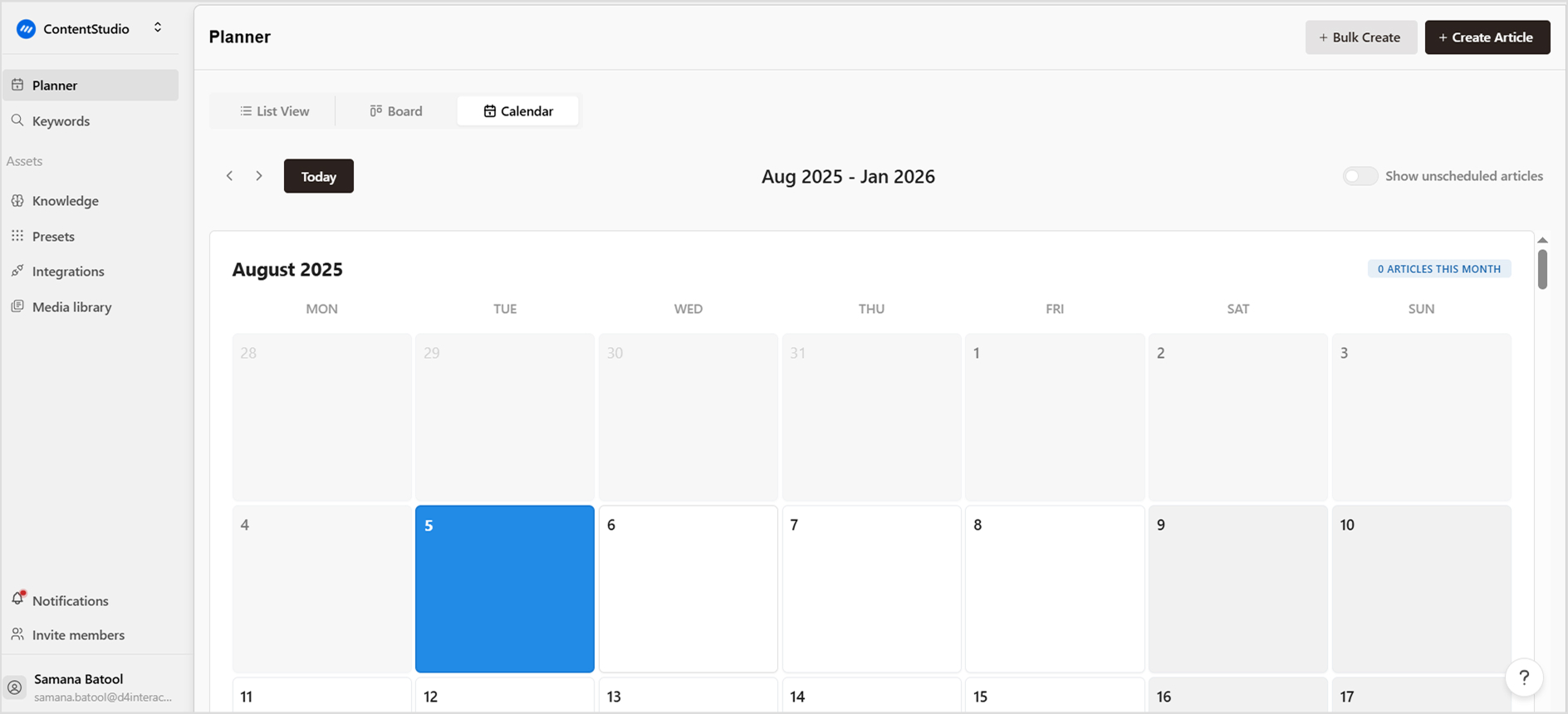
- Research and ideation: Stay informed about trends in your niche and regularly brainstorm new content ideas. Use keyword research tools to identify topics your audience is searching for.
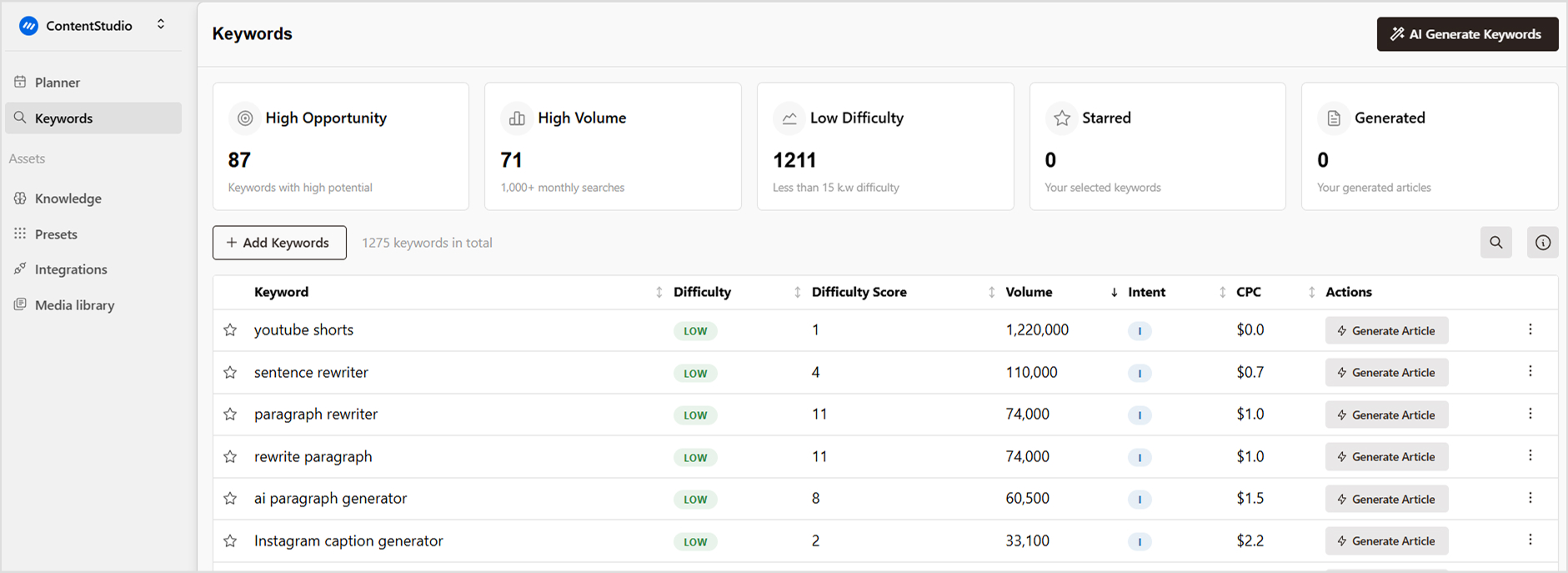
- Writing process: Develop a systematic approach to writing. Start with an outline to organize your thoughts, then write your first draft, focusing on getting ideas down without worrying about perfection.
- SEO optimization: Use the right type of keywords and implement SEO best practices to help your content rank in search engines. This includes optimizing titles, meta descriptions, headings, and incorporating relevant keywords naturally throughout your content.
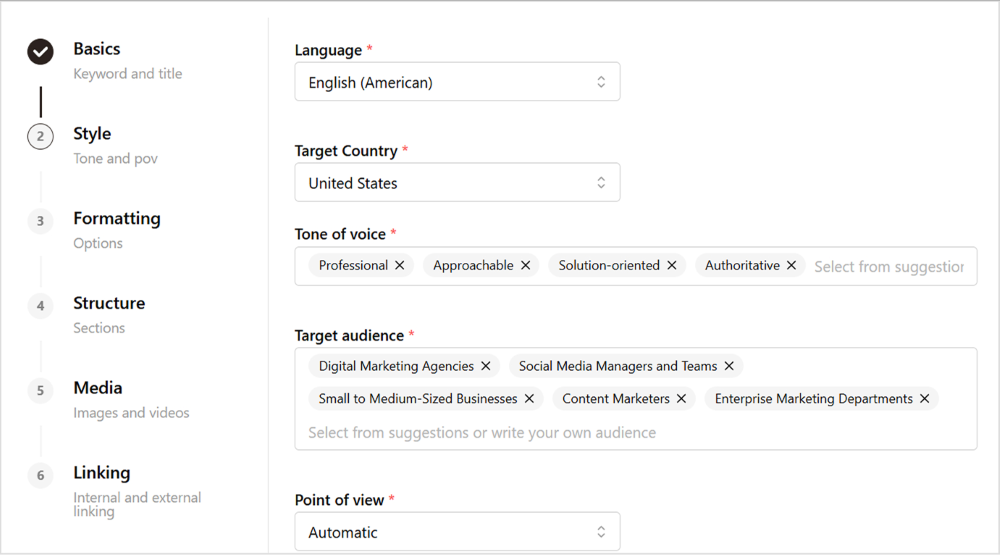
- Visual elements: Enhance your posts with images, infographics, videos, or other visual elements. Visual content improves engagement and helps break up text-heavy posts.
- Editing and proofreading: Never publish your first draft. Take time to edit for clarity, grammar, and flow. Consider reading your content aloud or using tools like Grammarly to catch errors you might miss during silent reading. You can also edit your content within Contentpen before directly publishing it your connected blog.
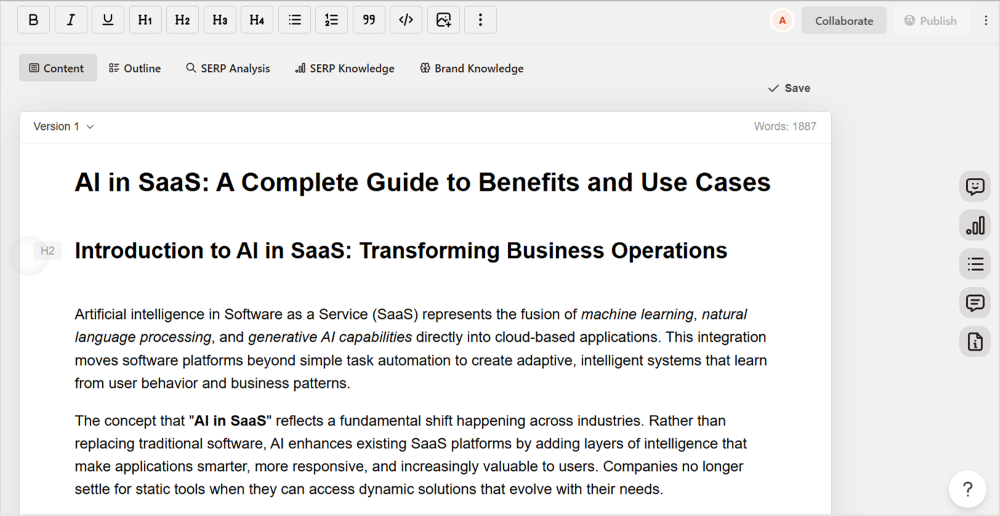
Step 4: Publish your optimized content
Publishing your content effectively involves more than simply hitting the “publish” button. This step requires attention to timing, formatting, and final optimizations to maximize your content’s impact.

- Optimal publishing times: Research when your audience is most active online and schedule your posts accordingly. While general best practices suggest certain days and times perform better, your specific audience may have different patterns.
- Categories and tags: Properly categorize and tag your content to help readers find related posts and improve site navigation. Use categories for broad topics and tags for specific details. Avoid creating too many categories or using irrelevant tags
- Final SEO check: Before publishing, review your SEO elements, including title tags, meta descriptions, alt text for images, and internal/external links. Ensure your content follow proper blog formatting guidelines for better readability and SEO performance.
Step 5: Promote and distribute your blogs
Creating great content is only half the battle, as you need to actively promote your blog posts to reach your intended audience. Some of the effective promotion strategies include:
- Social media marketing: Share your content across relevant social media platforms where your audience spends time. Each platform requires a different approach, such as LinkedIn for professional content, Instagram for visual posts, and X for quick updates.

- Email marketing: Build and nurture an email list by offering valuable content upgrades, newsletters, or exclusive content. Email marketing consistently delivers higher engagement and conversion rates compared to social media promotion.
- Guest posting: Write guest posts for other blogs in your niche to expand your reach and build backlinks to your site. This strategy helps you tap into established audiences and improve your blog’s SEO through quality backlinks.
- Influencer outreach: Connect with influencers and other bloggers in your niche. Building relationships can lead to collaboration opportunities, shares, and mentions that expose your content to new audiences.
- Content repurposing: Transform your blog posts into different formats like videos, podcasts, infographics, or social media carousels. This allows you to reach different audience preferences and extend your content’s lifespan across multiple channels.
Step 6: Engage your audience
Building an engaged community around your blog is essential for long-term success. Engaged readers are more likely to return, share your content, and eventually become customers if you’re monetizing your blog.
Here’s how you can improve audience engagement:
- Respond to comments: Actively respond to comments on your blog posts. This shows readers that you value their input and encourages further discussion.
- Create interactive content: Incorporate polls, quizzes, surveys, and questions in your posts to encourage reader participation. Interactive content generates higher engagement rates.
- Ensure consistent communication: Maintain regular communication with your audience through multiple channels. This includes consistent blogging schedules, regular email newsletters, and an active social media presence.

- User-generated content: Encourage your readers to create content related to your blog or niche. This could include sharing their own experiences, photos, or stories related to your content topics.
- Feedback implementation: Actively seek and implement feedback from your audience. Conduct surveys, ask for post suggestions, and pay attention to comments and messages.
Step 7: Use analytics for consistent growth
Sustainable blog growth requires consistent effort and strategic thinking. This phase focuses on scaling your content creation, expanding your reach, and building systems that support long-term success.

- Analytics and optimization: Regularly review your blog analytics to understand what content performs best, where your traffic comes from, and how visitors behave on your site.
- Content consistency: Establish a realistic publishing schedule and stick to it. Whether you post daily, weekly, or monthly, consistency helps build audience expectations and improves your search engine rankings.
- Scaling content production: As your blog grows, consider ways to increase content production without sacrificing quality. This might involve using AI for content creation, hiring freelance writers, or creating content in batches during dedicated writing sessions.
- SEO improvements: Continuously work on improving your blog’s search engine optimization. This includes updating old posts with new information, improving internal linking structures, and targeting new keywords as you identify opportunities.
- Networking and collaboration: Build relationships with other bloggers, industry experts, and potential collaborators. These connections can lead to guest posting opportunities, joint ventures, and cross-promotion that accelerate your growth.
- Diversifying content types: Experiment with different content formats to appeal to various learning styles and preferences. This might include video content, podcasts, infographics, or interactive tools related to your niche.
Step 8: Monetize your blog
Once you’ve established a consistent readership and built trust with your audience, you can explore various monetization strategies to generate income from your blogging efforts.

- Advertising revenue: Display ads through platforms like Google AdSense or direct partnerships with relevant brands. While this is often the first monetization method bloggers consider, it typically requires substantial traffic to generate significant income.
- Affiliate marketing: Promote products or services relevant to your niche and earn commissions on sales generated through your unique affiliate links. Success in affiliate marketing depends on building trust with your audience.
- Digital products: Create and sell digital products like e-books, online courses, templates, or tools. Digital products often have higher profit margins than physical products and can be sold repeatedly without additional production costs.
- Sponsored content: Partner with brands to create sponsored posts or reviews. Maintain transparency with your audience by clearly disclosing sponsored relationships, and only work with brands that align with your values and audience interests.
- Services and consulting: Offer services related to your expertise, such as consulting, coaching, or freelance work. Your blog serves as a portfolio and lead generation tool for your professional services.
- Membership or subscription models: Create premium content areas, exclusive communities, or subscription-based content for dedicated followers willing to pay for additional value.
Pros and cons of blogging
Understanding both the advantages and challenges of blogging helps set realistic expectations and prepare for the journey ahead.
The following table summarizes the pros and cons of blogging:
| Pros of blogging | Cons of blogging |
| Starting a blog requires minimal investment compared to traditional businesses | Requires significant time investment with slow initial returns |
| Complete control over your content, design, and business direction | Revenue can be unpredictable, especially early on |
| Work from anywhere at any time that suits your lifestyle | Saturated markets make it hard to stand out |
| Improves writing, marketing, SEO, and technical skills | Requires learning optimization and maintenance skills |
| Connects you with like-minded individuals and industry professionals | Constant demand for fresh, valuable content |
| Establishes you as an authority in your niche | Search engine changes can disrupt traffic |
| Various monetization options provide income diversification | Pressure to stay consistent may cause creative fatigue |
| Starting a blog requires minimal investment compared to traditional businesses | Requires significant time investment with slow initial returns |
| Potential to impact and influence people worldwide | |
| Blogs can continue generating traffic and income for years | |
| Unlike social media, your blog is fully yours | |
Free blogging platforms
If you are a complete beginner, you might not want to invest too much into blogging. Therefore, users looking to start blogging without any initial investment can explore several free platforms that offer robust features and user-friendly interfaces, such as:
WordPress
WordPress.com is the hosted version of WordPress. It offers a balance between ease of use and functionality. Moreover, it has professional themes, basic customization options, and reliable hosting.

While the free plan includes WordPress branding and limited customization, it’s an excellent starting point for new bloggers who want room to grow.
Blogger
Google’s blogging platform integrates easily with other Google services and offers unlimited storage and bandwidth. It’s particularly user-friendly for beginners and provides reliable hosting backed by Google’s infrastructure.

However, it has limited design flexibility and fewer advanced features compared to other platforms.
Medium
Medium platform focuses on writing quality and community engagement rather than technical setup.

Medium’s built-in audience and clean, distraction-free interface make it ideal for writers who want to focus purely on content creation. The platform handles all technical aspects, though monetization options are limited, and you don’t own your content’s platform.
Future of blogging
Blogging continues to evolve rapidly, driven by technological advances and changing consumer preferences. AI is increasingly becoming the future of blog writing services, transforming how content is created, optimized, and distributed.
Many people often ask, “Is blogging dead?” The answer is a clear no!
However, the way to succeed with blogging has changed dramatically. Simply publishing posts is no longer enough, as factors like SEO have become critical to standing out in an increasingly crowded space.
Moreover, artificial intelligence is at the center of this transformation. AI-powered tools are revolutionizing content creation by helping bloggers research topics faster, optimize posts automatically, and even generate first drafts.
Concepts like AIO (Artificial Intelligence Optimization) and Generative Engine Optimization (GEO) are becoming essential, as search engines and AI-driven platforms increasingly determine how content is discovered. Bloggers who adapt to these trends will have a better chance of reaching and engaging audiences in the age of AI.
At the same time, the human element remains irreplaceable. Readers still crave authentic perspectives, emotional connections, and creative insights that only real human experiences can provide. AI can speed up the writing process, and you can give it a final look with your human touch.
Despite these advances, the core principles remain unchanged: successful blogging will always rely on providing value, building trust, and creating authentic connections with readers.
Conclusion
Blogging represents one of the most accessible and powerful ways to build an online presence, share your expertise, and create meaningful connections in this digital world. While it has evolved significantly since the early days of simple web logs, the core principles remain unchanged: provide value, stay consistent, and genuinely connect with your audience.
The key is to start with choosing a suitable blogging platform, a niche that interests you, and writing engaging content to reach your target audience. Ultimately, by following the 8 steps of blogging discussed in this article and using the right blogging tools, such as a unified AI blog writer, you’ll be on the right track to start your blogging journey.
Frequently asked questions
Do bloggers get paid?
Yes, bloggers can earn money through various methods. This includes advertising, affiliate marketing, sponsored content, selling digital products, offering services, and creating membership programs.
Can anyone do blogging?
Absolutely! Blogging is accessible to anyone with internet access and something valuable to share. While success requires learning specific skills like writing, SEO, and marketing, these can be developed over time.
What is the 80/20 rule for blogging?
The 80/20 rule in blogging suggests that 80% of your results come from 20% of your efforts. This often means 20% of your posts generate 80% of your traffic, or 20% of your marketing activities drive 80% of your growth.
How long does it take to make money from blogging?
Most bloggers don’t see significant income for 6-12 months, and substantial income often takes 1-2 years or more. The timeline depends on factors like niche competition, content quality, marketing efforts, and chosen monetization methods.
You might be interested in...
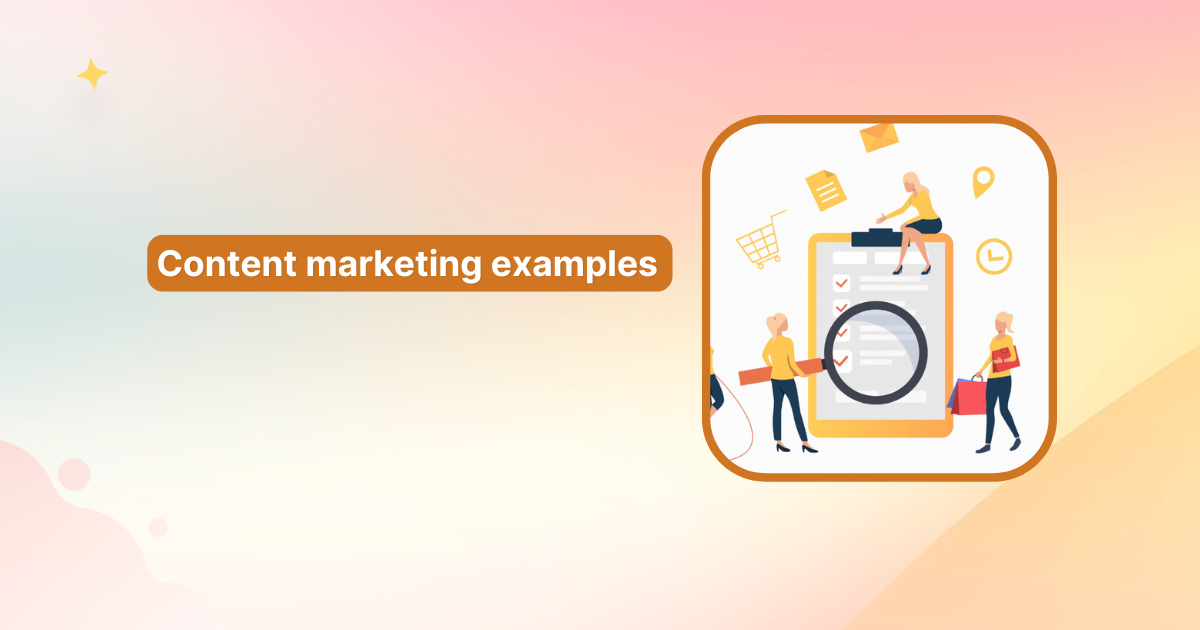
Content marketing examples that drive results in 2025
Here’s a sobering truth: 96% of content published online gets zero traffic from Google. Zero! Yet the examples you’re about to see generated millions of views, thousands of shares, and drove real business results. What makes them different? They didn’t follow the “publish and pray” strategy! Instead, each one used a specific psychological trigger, solved […]
Sep 29, 2025

What is blogging? The ultimate guide
Should I start my own blog? Is blogging dead? Can I get paid for blogging? What does blogging even mean in this age of AI? These are some of the most common questions associated with blogging, and we’ll be answering all of them in detail to understand what blogging is. Blogging has changed a lot […]
Sep 17, 2025

What is a blog: meaning, elements, types, and more!
Whether you’re completely new to the digital world or looking to expand your online presence, understanding what a blog is is essential in today’s content-driven landscape. A blog serves as your digital voice, allowing you to share ideas, build communities, and even generate income. In this comprehensive guide, we’ll explore everything you need to know […]
Sep 17, 2025